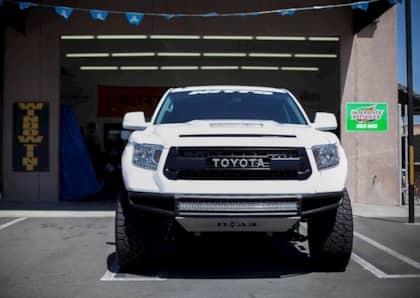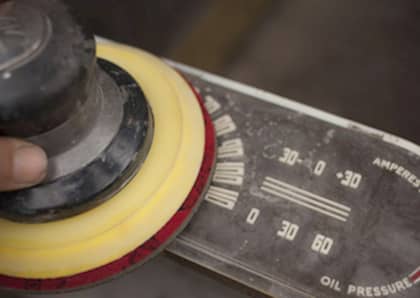The 10 Simplest Repairs You Ought to Do Yourself
It isn’t about the $4 you’ll save by changing your own oil. Sometimes the satisfaction you get from doing it yourself, becoming a little bit more familiar with your car or keeping the schmo at the quickie lube from bungling up your oil pan (yet again) are more important.
Here are the top 10 car repairs you can, and should, do yourself:
1. Battery

Swapping out your car’s dead battery for something that’ll hold a charge and let your starter kick over in the morning is something you can probably do, but approach all of this with a little bit of caution.
Start by locating the battery, which might be underneath the hood, behind a seat or in the trunk, and before you even think about doing anything else, disconnect the cable from the battery’s negative terminal and tuck it out of the way. From here it’s a matter of removing whatever sort of bracket holds the battery in place and disconnecting the positive cable from its terminal. Once the new battery’s in place, hold off on connecting the negative terminal’s cable until everything else is put back. If you’re smart, you’ll use some sort of wire brush to clean both cables’ connectors and restrain yourself against over-tightening them, which’ll only do the opposite of what you think.
2. Spark Plugs

Replacing an engine’s spark plugs has become one of two things: a whole lot more complicated than it used to be and, a lot of times, unnecessary. Blame the first part on the array of plastic covers that surround your engine’s cylinder head and the second on how darn efficient modern-day engines have become, making once-routine maintenance not so routine anymore.
If you’re able to locate each of your engine’s spark plug wires or coils (depending on what kind of ignition system you’ve got), then you might be up for all of this. Once the plug wires or coils have been pulled away, remove the plugs. You’ll be happy you grabbed your special spark plug socket for all of this with its rubber insert that’ll make retrieving the plugs once loose a whole lot easier. Do your future self a favor, too, and apply anti-seize to the new plugs’ threads before installing them.
3. Oil and Filter
It used to be that your being able to change your own oil was your automotive rite of passage. The twenty-dollar quick-lube’s made that passage a whole lot harder to justify, though. But if you’re the kind of person who’s bothered by stripped oil pan plug threads at the hand of minimum-wage greenhorns, then you should probably be doing this one yourself.
You already know how important it is to raise and secure whatever it is you’ll be lubing with the right jack and jack stands. An oil change isn’t hard and really only consists of you draining what’s inside of your engine block by means of that oft-stripped plug located on the bottom of the oil pan and, once empty, swapping out filters. You’ll need a wrench for the drain plug but, most of the time, bare hands can undo a filter. Also, be sure you’re draining the right stuff; there’s a transmission someplace underneath there, too, that you ought not to be messing with.
4. Drive Belts

We’re not talking about timing belts where you bungling up the installation can lead to all sorts of expensive mistakes, like valves and pistons that become too good of friends. Drive belts and serpentine belts, as important as they are, will rarely lead to any sort of catastrophic engine damage. At some point those rubber belts that keep things like water pumps, alternators, A/C compressors and power steering pumps spinning around have got to be changed, though. You’ll know it when they start squealing, fraying, exhibiting cracks or get chucked from your engine bay onto the side of the road.
Automatic tensioners make all of this fairly easy. Most of the time, it’s as simple as using a wrench to rotate the tensioner and slipping the belt right off of its pulleys. In some cases, things like engine mounts or cooling fans may need to be removed in order to get the belt out of there, in which case something simple all of a sudden got a whole lot more complex.
5. Air Filters

Most modern cars have at least two different air filters: one for the engine that keeps debris out of your crankcase, and one for the interior that keeps debris out of your lungs. Most newer cars make changing either of them about easy as you plugging in an iPod. Engine air filters can typically be found inside of the plastic tubing that spans toward your engine’s intake manifold and, a lot of times, can be accessed without tools by unfastening a series of clips or latches. Cabin air filters are often stowed behind the glove compartment and can also be pulled out and replaced with nary a wrench.
6. Fluids

No matter how many thumbs you’ve got, the chances of you successfully topping off your car’s vital fluids are in your favor. Unless your owner’s manual tells you otherwise, allow things to cool down underneath the hood before pulling dipsticks, taking readings and topping things off. And control yourself when it comes to the temptation of adding more fluid than what all of those important marks say you really need. Most of the time, excess engine oil, transmission fluid or coolant will result in all sorts of problems, like leaks and a transmission that just won’t shift right.
7. Headlight/Taillight Bulbs
Unless you’ve got factory-sealed headlights that whoever built your car doesn’t want you messing with, swapping out a burnt-out lightbulb isn’t all that hard. Once you’ve popped the hood or the trunk and pulled away any covers or carpeting that might be in the way, unscrew the plastic housing from the headlamp or taillamp assembly that holds the bulb in place. You probably won’t need to disconnect the electrical connector from the housing to get the bulb out, but if you do, look for for a small retaining clip on the connector that’s got to be depressed before it can be released. Don’t be that guy who breaks these connectors; if it doesn’t want to budge, you’re not pressing that clip hard enough.
8. Fuses

You thought it was a burnt-out bulb and you thought wrong. Whatever it is that you drive’s most likely got more than one fuse box, but every one of them ought to have some sort of label or markings that let you know which fuse does what. Most of the time, you’ll find the fuse box underneath the hood, on the side of the dash or someplace near where your (or your passenger’s) feet go. Refer to the label or markings to find the fuse you’re looking for, confirm that it’s blown and swap it for a good one of the same amperage. A fuse that’s rated too low will pop again and one that’s too big can cause all sorts of fire-induced electrical drama.
9. Brake Pads

That squealing sound emanating from your wheel well probably means you need new brake pads, which, most of the time, you ought to be able to do yourself. That grinding sound, though, that’s something a whole lot more complicated—and expensive—and usually points to a problem with the rotors or calipers, in which case now is a good time to bring your mechanic a fruit basket.
But yours are squealing—not grinding—which means the job just got a whole lot cheaper. Your brake pads sit inside of calipers that are sandwiched around the rotors. Most of the time, getting the pads out is as easy as removing a bolt on the caliper and swinging it out of the way. Before doing any of this, though, run your fingernail along the rotor, from the center out. If it hangs up easily, you ought to remove the rotors, too, and have them resurfaced at your local auto parts store or machine shop. When doing all of this, avoid disconnecting any brake lines or hoses, lest you be buying another fruit basket.
10. Cap and Rotor

It’s your distributor that determines when and in what order your engine’s cylinders create those little explosions that keep everything spinning around. Unless, of course, you’ve got individual ignition coils, which most newer cars do, in which case you can politely stop reading now.
It takes a long time for a distributor to fail, but it’s its plastic cap and rotor that’s responsible for phasing everything correctly that you’ve got to worry about. Look to both of these when encountering typical ignition problems or sputtering and don’t waste your time replacing one without the other. You’ll find the distributor on the outside of your engine, located at either end of the cylinder head. Most of the time, the cap and rotor can be swapped out with nothing more than a screwdriver and 10 minutes of your life.











